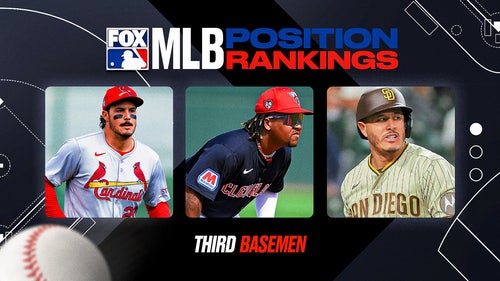
Cleveland Indians: Three Reasons the Tribe Will Beat Toronto

Oct 13, 2016; Cleveland, OH, USA; General view of the ALCS logo on the field one day prior to game one of the ALCS between the Toronto Blue Jays and Cleveland Indians at Progressive Field. Mandatory Credit: Ken Blaze-USA TODAY Sports
The Cleveland Indians are underdogs in the ALCS against the Toronto Blue Jays despite having home-field advantage. What can the Tribe do to pull off the upset?
When the American League Championship Series gets underway at Progressive Field on Friday night, it will feature arguably the two hottest teams in all of Major League Baseball. Going back to the end of the regular season, both the Cleveland Indians and Toronto Blue Jays have won six games in a row, seven of their last ten, and are coming off sweeps in the ALDS.
While Cleveland has the home-field advantage and has been every bit as impressive as Toronto, the Indians are considered the underdogs in the series. That’s just fine with the team, which has used an “us against the world” mentality throughout a season that has been filled with injuries and adversity.
“We were the underdogs coming out of [the Boston series],” second baseman Jason Kipnis said. “Nobody predicted we were coming out of this one. Across the board on ESPN and everybody. Those are the people to prove wrong. But, we’re focusing more on the people to prove right, the ones in here who are on our side, and we’re looking forward to the next stage.”
The Tribe met the Blue Jays seven times in the regular season, taking the series 4-3, but were outscored 38-24 in those games. A 17-1 win by the Jays on July 3rd skews those results, though, and all six other games were decided by three runs or less, including four one-run games.
“We’re so evenly matched, it’s unbelievable,” Indians pitching coach Mickey Callaway said. “They probably do it a little bit of a different way than we do it, but this is going to be probably the best series that you’re going to see all postseason, as far as the way we match up against each other. It’s going to be fun.”
On paper, at least, this promises to be a closely-contested, hard-fought series between two clubs who were given little chance by the experts when the playoffs began. With a trip to the World Series on the line, we wouldn’t want it any other way.
So how can Cleveland come out on top and earn that berth in the Fall Classic?
Baserunning
Oct 7, 2016; Cleveland, OH, USA; Cleveland Indians left fielder Brandon Guyer (6) scores against Boston Red Sox catcher Sandy Leon (3) on a sacrifice fly by Indians center fielder Rajai Davis (not pictured) in the sixth inning in game two of the 2016 ALDS playoff baseball series at Progressive Field. Mandatory Credit: David Richard-USA TODAY Sports
Heading into the division series against the Red Sox, there was a near-consensus among baseball writers and analysts that the Indians’ team speed would be one of the most critical factors in determining the outcome. Instead, the Tribe stole just one base in the three games and relied on the home run ball to generate its scoring.
The ALCS is a whole new ballgame, though, and Cleveland has a decided advantage on the basepaths that it must use to put pressure on Toronto’s pitchers and defense.
The Tribe stole 134 bases as a team during the regular season, with an AL-best 81 percent success rate, and boast four players who swiped at least 15. Rajai Davis, at the age of 35, stole a league-leading 43 bases in 48 attempts (roughly 88 percent), followed by Jose Ramirez (22), Lindor (19), and Kipnis (15).
Blue Jays catchers Russell Martin and Dioner Navarro combined to throw out just 14 of 80 would-be base stealers this season, a paltry 17.5 percent. Overall, Toronto was third-worst in all of baseball at throwing out runners, and its pitching staff is among the slowest in delivering the ball to the plate, all of which tilts the running game in the Indians’ favor.
But swiping bags is only part of the equation. Cleveland was also the best in the league at taking extra bases, claiming 186 of them on fly balls, passed balls, wild pitches, balks, and defensive decisions, and at advancing the extra base on balls in play, which they did at a 45 percent rate.
Toronto doesn’t possess the most explosive stable of outfield arms, so it appears likely the Indians can continue to be aggressive when running, taking extra bases and challenging the Jays to make a play. According to FanGraphs, Blue Jays outfielders ranked 23rd in MLB in “Arm” rating, which takes into account both assists and preventing the opposition to take extra bases.
Despite these apparent advantages, though, Toronto’s players downplayed the significance of the Tribe’s team speed.
“Numbers lie,” Martin said. “That’s why if they want to take their chance, what I’m best at in life is catching and throwing. I don’t want to sound overconfident, but it’s a big part of my game. So to me, it’s a non-issue … Controlling the basepaths is something I’ve done my whole career, and it’s exciting for me. I like when people run. It gives me a challenge, and I love challenges. I hope they run a lot.”
We’ll have to wait and see how the running game factors into the ALCS, but Martin may end up regretting those words if he gets what he asked for.
Pitcher Usage
Oct 10, 2016; Boston, MA, USA; Cleveland Indians relief pitcher Andrew Miller (24) delivers a pitch in the sixth inning against the Boston Red Sox during game three of the 2016 ALDS playoff baseball series at Fenway Park. Mandatory Credit: Bob DeChiara-USA TODAY Sports
I was very careful to title this “Pitcher Usage,” as I’m not talking exclusively about the bullpen. Cleveland manager Terry Francona has proven over and over that he is among the very best in the game at orchestrating his pitching staff, and the Boston series was a master class in the skill of putting the best arms in the biggest situations.
Of the 27 innings played between the Indians and Red Sox, the five best members of the staff – comprised of Corey Kluber, Cody Allen, Andrew Miller, Bryan Shaw, and Dan Otero – threw 17.1 of them, or 64 percent. That’s utilizing the most high-impact arms in the most high-leverage situations, and a key factor in the Tribe getting the sweep.
That sort of usage will not be possible in the ALCS, though, with more games being played and fewer opportunities to rest. Francona will once again have to prove his mettle in going deeper into the bullpen against Toronto, and starters Trevor Bauer and Josh Tomlin, along with Mike Clevinger, may be called upon to go deeper into games.
“We’ve got our hands full,” Callaway said. “We used four relievers the whole [Division Series], our top guys. That’s not going to happen in a seven-game series. We’ve going to have to have some guys step up and step up in a big way.”
A closer look at bullpen usage shows that Shaw and Otero only combined for 3.1 innings of work in the ALDS, a mark that can be increased. Allen and Miller also experienced some uncharacteristic command issues, and with better economy can likely eat up more innings.
But the remaining relief corps will also be required to play a role if the Tribe is to advance to its first World Series since 1997. Among them, the key may well be rookie Mike Clevinger, who has thrived since being recalled from the minor leagues in early August. Clevinger is the probable Game Four starter, but will be available in the bullpen through the first two games, and saw improvements in his strikeout rate, strikeout-to-walk ratio, WHIP, and opposition slash line over the final two months of the season.
Cody Anderson and Ryan Merritt provide Francona with two arms that can give some length if needed, and Zach McAllister was lights out after the all-star break, giving Francona another hard-throwing option for higher leverage situations.
Still, it would be unwise to abandon what has gotten Cleveland this far, and for the most part that is Kluber and the big four in the bullpen. Situations will dictate how usage plays out, but it wouldn’t be surprising – it might even be preferable – to see Kluber inserted on short rest or Allen and Miller in multiple games in a row.
Home-field Advantage
Oct 7, 2016; Cleveland, OH, USA; Cleveland Indians hold up signs in the sixth inning against the Boston Red Sox in game two of the 2016 ALDS playoff baseball series at Progressive Field. Mandatory Credit: David Richard-USA TODAY Sports
The Indians won 53 games at Progressive Field during the regular season, along with the two games played there during the division series. This is a team that thrives in front of its home fans.
Cleveland is a completely different offensive team at the corner of Carnegie and Ontario:
The atmosphere inside Progressive Field during Games One and Two of the ALDS was electric, there’s no other way to describe it. Several players remarked about it, and it’s clear the Indians feed off the energy of the home crowd.
“I couldn’t even hear myself think at the end of the game,” Mike Napoli said of the crowd noise after Game One. “We’re going to need that. We feed off of them.”
Sweeping the final regular season series at Kansas City may not have appeared at the time to have been an overly big deal, but it can’t be stressed enough how vital having home-field advantage is to the Indians. Not simply in terms of comfort and familiarity, but in terms of production, which will be needed against a powerful Toronto offense that just bludgeoned the top-seeded Texas Rangers.
The regular season goes out the window once the playoffs get started, as the small sample size makes truly anything possible. But it’s difficult to argue that the Tribe doesn’t benefit in some way, no matter how small, by opening the ALCS right here in Cleveland.
“In terms of the crowd, the red towels were out just like last time, and they were loud when they needed to be, and loud when they didn’t need to be,” Kipnis said. “And that’s just exactly what you want out of a hometown crowd.”
More from Wahoo's on First
This article originally appeared on





